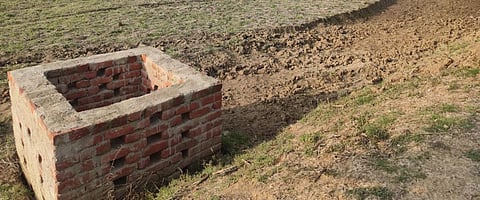

Hundreds of water-conservation structures are supposed to have come up under the Narendra Modi government's Jal Shakti Abhiyan (JSA) scheme in Bihar's Gaya district. But have they?
Spread over a geographical area of 4,976 square kilometres in southern Bihar, the district has a total population of 4,391,418. Of these, a population of 3,803,888 lives in 2,886 villages.
The JSA was launched in mission mode in 2019, after a speech by Prime Minister Narendra Modi to harvest water. Under the JSA, a total of 1,592 blocks in 256 districts, facing water crisis, were selected in 36 states and Union territories of the country.
These included 312 critical blocks and 1,186 over-allocated blocks. Gaya was one of the districts selected. Within Gaya, the Dumariya, Imamganj and Manpur blocks were selected for the campaign.
Down To Earth, however, found several discrepancies in what the district administration claimed it had done under the JSA and the situation on the ground.
Take, for instance, Govind Saw of Bhangia village in Dumariya. His father Pankaj received Rs 1.5 lakh under the Mahatma Gandhi Rural Employment Guarantee Act to build a well on his farm. Block officials claimed the well was built between July 1 and September 15, 2019 — in JSA's first of two phases.Saw claimed the well was built in January 2019.
DTE, however, found that it was built in 2018. The district administration took an aerial view of the well and counted it among JSA works.
There were discrepancies regarding soak pits attached to handpumps too. As part of the campaign, about six feet of soak pits were to be made in blocks for reuse of water and recharging ground water.
Officials in Imamganj claimed five bore-well recharges and 12 soak pits were installed in Raniganj during the campaign. However, villagers in Jamuna denied the knowldge of those.
Work regarding roof-water harvesting was also not satisfactory. DTE could not spot them at government primary schools, community buildings and other government buildings in many villages. The government claimed to have installed 24 such systems in Dumariya and 17 in Imamganj.
In Dumariya, DTE did come across one such system at a community building next to the government primary school in Bodhi Vigha village, but its construction did not follow standards: The roof pipe mouth was protruding and the pipe water could not reach the two pits built below for filtering and storage as the pipe connection was broken in the middle. Block officials said on February 27, 2020, a thunderstorm and rain caused the pipe to break.
Moreover, the pit receiving water from the roof is located near toilet pits. In such a situation, even if rainwater was stored, it could become contaminated. According to rules, the pit should be located 10 metres away from toilet pits.
There was no agency overseeing rooftop harvesting nor does the administration have funds to oversee it, the Dumariya Block Programme officer told DTE.
Plantation works
Intense afforestation is also part of the JSA campaign.
In Gaya district, 15 per cent of the area is forested. However, according to documents, the district is rapidly losing natural forests as the government is placing more emphasis on timber-based forestry.
As part of the JSA, the programme officer had claimed that a total of 33,400 public and 7,400 private plantations had been made in Dumariya and 151,600 public and 11,600 private plantations had been in Imamganj block.
“We are working to create a watershed to fix the degraded land within the forest area. Work will be done in 6,517 hectares of forest area before this monsoon and 7,000 hectares by next year,” district forest officer Abhishek Kumar told DTE.
“Staggered trenches are being built on hillocks to stop water flowing down during the rainy season and increase the soil moisture. A total of 138 forest committees are functioning in Gaya. Forestry work is being done through these committees,” Kumar added.
Gaya got a total of 62.30 marks under the JSA. These included those awarded for intensive plantation. However, during the campaign, the district got only 0.76 points out of the total 14 per cent in intensive plantation.
It is clear from this that intensive plantation was not done during the campaign. At the same time, officials said that a comprehensive plantation programme will be done under Bihar’s Jal Jeevan Hariyali programme in the future.
Traditional water bodies still await help
No work has been done on traditional water structures under the JSA. The Sarohar river flows beyond Ballia village in Dumariya block.
An old community well was built on the banks of this river. Water from this well was extracted through tube wells and used for irrigation. However, it was found in a dilapidated state.
Similarly, old structures of irrigation in the villages have become useless. A pond has been constructed in Rasalpur village of Manpur block through JSA. The administration claimed that it also involved people's participation.
“Under the Jal Shakti Abhiyan, a water reuse plant has been built in Rasalpur village of Manpur, but it has not been started yet,” Gaya District Magistrate Abhishek Singh told DTE.
Gaya district has its very own traditional rainwater harvesting system called Aahar Paeen. Officials said that these structures were encroached and in need of desiltation. They promised to work on it.